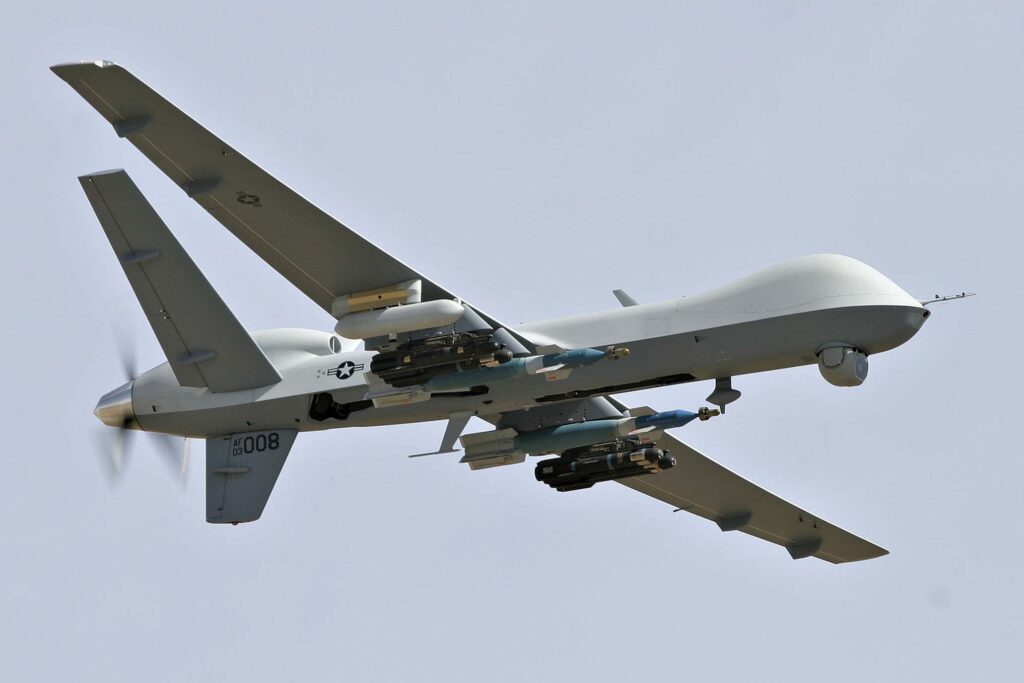Create Executive Agent For Drones: AFA’s Mitchell Institute
Posted on

Drones are designed and bought by the four services, as well as DARPA and, we suspect, an intelligence agency or two. There’s duplication of effort and requirements overlap and that means wasted money and time. Many moons ago in 1993, when drones were just becoming a thing in the US military, some visionaries created the Defense Airborne Reconnaissance Office, led by then-Maj. Gen. Kenneth Israel. As Tom Ehrhard chronicles in his excellent Mitchell Institute study of that period, DARO “was given full budget authority over DOD UAV development and upgrades, thereby supplanting the Title X “equip” function of the services. The services retained full capacity to operate UAVs and participated in the DARO process, but lost a substantial degree of control over UAV development.” You can imagine how long that lasted (hint — less than five years).
Now, a new report by the Mitchell Institute recommends creation of a different animal, “an executive agent to coordinate medium-altitude and high-altitude drones across the various services.” This sounds a great deal like what the Air Force did with space to try and improve space acquisition and better integrate white and black space (classified and public) — create an executive agent. For space, the Office of Secretary of Defense compromised by lodging authority for “planning, programming, and acquisition of space systems” with the executive agent and picking someone to do it who didn’t make the biggest stakeholders in space angry: the Air Force Secretary. So you had one source coordinating all space systems and that source was the head of the service that built most of the space systems. The head of the Mitchell Institute, David Deptula, offers a more detailed explication of where the drone enterprise should head. Read on! The Editor.

David Deptula
The Defense Department is struggling to meet the ever-rising demand for drones (which the Air Force calls Remotely Piloted Aircraft). Despite efforts by the Office of the Secretary of Defense and military services to surge drone capacity, their collective actions have been largely uncoordinated, yielding a disjointed enterprise where effectiveness and efficiency are not what they can be.
With large wartime budgets shrinking, the military must make a host of important decisions regarding how best to meet valid requirements in a sustainable fashion. These decisions will affect all aspects of the drone enterprise, from personnel policy and training to organization and acquisition, to force allocation and employment.
The Mitchell Institute for Aerospace Studies spent the past year examining this subject and just released a report prescribing actions that will yield a far more capable and viable enterprise. We investigated four areas: near-term actions to alleviate stress on the force; technologies to reduce manpower requirements, boost mission efficiency and rapidly seize new opportunities; how to streamline the acquisition process to facilitate buying modern drone technology; and optimizing the organizations involved to get greater capability by aligning the use of systems in a more efficient and effective fashion.
We recommend that:
- The Air Force accelerate the installation of automated takeoff and landing systems on all MQ-9 Reaper aircraft. Since the fielding of the MQ-1 Predator and MQ-9 Reaper, the majority of mishaps have occurred during the takeoff and landing phases of flight, with most of those accidents attributed to pilot error. During this same period, the Army began fielding its MQ-1C Gray Eagle with an integrated automated takeoff and landing system. As of early 2016, this technology has resulted in more than 75,000 Gray Eagle takeoffs and landings without a single mishap. The Air Force’s RQ-4 Global Hawk also uses a built-in, automated takeoff and landing system and has suffered no associated mishaps. The service has sought to install this capability on the Reaper, but budget constraints have slowed this. By industry estimates, preventing the loss of three Reapers—at $15 million per aircraft—in landing accidents would more than fully fund the cost of fielding automated takeoff and landing on every Air Force MQ-9.
The Air Force would also harvest additional savings since automated takeoff and landing technology obviates the need for launch and recovery element (LRE) aircrews at the forward bases from which Reapers fly. These LRE crews operate the drone during takeoff with line-of-sight radio control. LRE personnel then hand the aircraft off to a mission crew in the continental United States (CONUS). When the sortie is complete, the CONUS crew returns control to the LRE operator for landing. The burden is large enough today that the Air Force is currently creating dedicated LRE squadrons. By using automated takeoff and landing technology, the same CONUS crews who fly Reaper missions would be able to take off and land the aircraft. The Air Force would no longer need LRE aircrews, saving significant funds for training, maintenance, and deployment. This would also make Air Force drone units easier to deploy. Crews previously assigned to the LRE training and deployment pipeline would now be available for flying operational missions.
As an example of technology’s role in boosting mission effectiveness, we concluded that open mission systems and modular technology are two of the most important investments the services can make in promoting mission responsiveness, accelerating acquisition, and managing development risk. Combatant commanders need the flexibility to rapidly customize sensor payloads. This will allow the finite number of assets to be optimally employed as mission demands require. This stands in contrast to hauling a full load of sensors on a given mission, whether they are required or not.
It will also allow the development of aircraft and sensor technology on independent tracks, meaning challenges in one area will not undermine the total mission system. By divorcing the drone “truck” from the sensors, the Air Force could incentivize actors to better manage risk, try new ideas, and pursue upgrades. Failure with a specific sensor or a platform variant would not undermine the entire system. This is comparable to a smartphone and associated applications. The device still functions with remaining applications, with the new app uploaded when it is technically mature. This sort of flexibility does not exist today, where the sensors and aircraft system are highly integrated in an interdependent fashion.
Our investigation also highlighted that the present acquisition system is limiting the speed and agility at which new upgrades can be fielded. Commercial high-tech companies field new systems every few months while the US military takes years just to write requirements and decades to field major equipment. No one uses a 1990s-era cellphone these days, but even the newest drone in the Department of Defense’s inventory are based largely on 1990s technology. This must change, especially if the US military is to maintain or increase its qualitative edge compared to potential adversaries.
Even as the Air Force and the Department of Defense have sought to accelerate drone acquisition, the acquisition bureaucracy has dogged these efforts. As one industry leader explained: “The [unmanned aerial vehicle] technology area is still rapidly changing. The Air Force never should have adopted something [i.e., an acquisition approach] that is going to work so slow with this technology.” An example of this is that until recently it took the Air Force more than three years to field the latest software block upgrades for its Reaper fleet. Program changes have brought the fielding timeline down to every 12 to 18 months. This is still too slow—we need to incorporate change at the speed of combat, not bureaucracy.
Drones are the perfect vehicles for implementing and testing new approaches to development and acquisition, for the risk is lower without personnel onboard, and circumstances are demanding faster results.
Finally, it is important to emphasize that problems are not solved by simply buying new hardware. Real success demands a holistic assessment regarding the way in which drones are used. In this vein, it is important to note that the Pentagon continues to segregate service approaches to drone concepts of operation, airspace control, defense against enemy attack, and acquisition. No single office is responsible for or empowered to integrate drone efforts across the Defense Department. This anachronistic approach continues to yield tremendous inefficiencies, capability gaps, and costly redundancies.
It is time to change.
We recommend that:
- The Defense Department create an executive agent to coordinate medium-altitude and high-altitude drone across the various services. This could reduce or eliminate acquisition duplication of effort; reduce RDT&E funds and timelines; reduce logistics and sustainment funding requirements by eliminating redundancies; increase interdependency and interoperability; build joint solutions; and provide more capability more quickly. This would be more efficient and cost-effective than the individual services duplicating their efforts. It would also empower DOD with better buying power because the services could coordinate their investment strategies to leverage savings through volume buys, common equipment, etc.
These are just some of the opportunities we think can be pursued to improve what is generally recognized as a critically important, but sub-optimized mission area. In undertaking this study, we observed that many of the solutions have already been identified and respective technologies developed. But it will take decisive leadership to implement the common sense solutions we recommend.
Above all, success will only be possible by prioritizing national security objectives and keeping an open mind about how best to meet those overarching goals. This demands taking an enterprise-wide perspective across DOD, capitalizing on the strengths of each of the service approaches, exploring new modes of operation, and exploiting new technological capabilities.
David Deptula, a retired Air Force lieutenant general, planned the Desert Storm air campaign, orchestrated air operations over Iraq and Afghanistan and oversaw the dramatic increase in Air Force drone forces in the mid 2000’s. A member of the Breaking Defense Board of Contributors, Deptula is dean of the Air Force Association’s Mitchell Institute for Aerospace Power Studies.
Subscribe to our newsletter
Promotions, new products and sales. Directly to your inbox.
